#Low-Cost Airline Market
Explore tagged Tumblr posts
Text
Southwest Airlines Exits Bellingham: A Setback in Expansion Plans
Southwest Airlines’ Departure from Bellingham Three years ago, Southwest Airlines embarked on a new venture by launching flights from Bellingham, Washington, a burgeoning city located near the Canadian border. The airline aimed to replicate its successful model in numerous smaller airports, providing affordable travel options for passengers with limited choices. Local officials and residents in…
#airport operations#aviation challenges#Bellingham#flight services#low-cost travel#market performance#pandemic recovery#Southwest Airlines
0 notes
Text
Low-Cost Carrier Airlines Market: Soaring into Affordability Explore the Skies with Low-Cost Carrier Airlines. Uncover Market Trends, Affordable Travel Options, and Future Projections. Your Guide to Budget-Friendly Flying. 🛫
0 notes
Text
Things the Biden-Harris Administration Did This Week #28
July 19-26 2024
The EPA announced the award of $4.3 billion in Climate Pollution Reduction Grants. The grants support community-driven solutions to fight climate change, and accelerate America’s clean energy transition. The grants will go to 25 projects across 30 states, and one tribal community. When combined the projects will reduce greenhouse gas pollution by as much as 971 million metric tons of CO2, roughly the output of 5 million American homes over 25 years. Major projects include $396 million for Pennsylvania’s Department of Environmental Protection as it tries to curb greenhouse gas emissions from industrial production, and $500 million for transportation and freight decarbonization at the ports of Los Angeles and Long Beach.
The Biden-Harris Administration announced a plan to phase out the federal government's use of single use plastics. The plan calls for the federal government to stop using single use plastics in food service operations, events, and packaging by 2027, and from all federal operations by 2035. The US government is the single largest employer in the country and the world’s largest purchaser of goods and services. Its move away from plastics will redefine the global market.
The White House hosted a summit on super pollutants with the goals of better measuring them and dramatically reducing them. Roughly half of today's climate change is caused by so called super pollutants, methane, hydrofluorocarbons (HFCs), and nitrous oxide (N2O). Public-private partnerships between NOAA and United Airlines, The State Department and NASA, and the non-profit Carbon Mapper Coalition will all help collect important data on these pollutants. While private firms announced with the White House plans that by early next year will reduce overall U.S. industrial emissions of nitrous oxide by over 50% from 2020 numbers. The summit also highlighted the EPA's new rule to reduce methane from oil and gas by 80%.
The EPA announced $325 million in grants for climate justice. The Community Change Grants Program, powered by President Biden's Inflation Reduction Act will ultimately bring $2 billion dollars to disadvantaged communities and help them combat climate change. Some of the projects funded in this first round of grant were: $20 million for Midwest Tribal Energy Resources Association, which will help weatherize and energy efficiency upgrade homes for 35 tribes in Michigan, Minnesota, and Wisconsin, $14 million to install onsite wastewater treatment systems throughout 17 Black Belt counties in Alabama, and $14 million to urban forestry, expanding tree canopy in Philadelphia and Pittsburgh.
The Department of Interior approved 3 new solar projects on public land. The 3 projects, two in Nevada and one in Arizona, once finished could generate enough to power 2 million homes. This comes on top of DoI already having beaten its goal of 25 gigawatts of clean energy projects by the end of 2025, in April 2024. This is all part of President Biden’s goal of creating a carbon pollution-free power sector by 2035.
Treasury Secretary Janet Yellen pledged $667 million to global Pandemic Fund. The fund set up in 2022 seeks to support Pandemic prevention, and readiness in low income nations who can't do it on their own. At the G20 meeting Yellen pushed other nations of the 20 largest economies to double their pledges to the $2 billion dollar fund. Yellen highlighted the importance of the fund by saying "President Biden and I believe that a fully-resourced Pandemic Fund will enable us to better prevent, prepare for, and respond to pandemics – protecting Americans and people around the world from the devastating human and economic costs of infectious disease threats,"
The Departments of the Interior and Commerce today announced a $240 million investment in tribal fisheries in the Pacific Northwest. This is in line with an Executive Order President Biden signed in 2023 during the White House Tribal Nations Summit to mpower Tribal sovereignty and self-determination. An initial $54 million for hatchery maintenance and modernization will be made available for 27 tribes in Alaska, Washington, Oregon, and Idaho. The rest will be invested in longer term fishery projects in the coming years.
The IRS announced that thanks to funding from President Biden's Inflation Reduction Act, it'll be able to digitize much of its operations. This means tax payers will be able to retrieve all their tax related information from one source, including Wage & Income, Account, Record of Account, and Return transcripts, using on-line Individual Online Account.
The IRS also announced that New Jersey will be joining the direct file program in 2025. The direct file program ran as a pilot in 12 states in 2024, allowing tax-payers in those states to file simple tax returns using a free online filing tool directly with the IRS. In 2024 140,000 Americans were able to file this way, they collectively saved $5.6 million in tax preparation fees, claiming $90 million in returns. The average American spends $270 and 13 hours filing their taxes. More than a million people in New Jersey alone will qualify for direct file next year. Oregon opted to join last month. Republicans in Congress lead by Congressmen Adrian Smith of Nebraska and Chuck Edwards of North Carolina have put forward legislation to do away with direct file.
Bonus: American law enforcement arrested co-founder of the Sinaloa Cartel, Ismael "El Mayo" Zambada. El Mayo co-founded the cartel in the 1980s along side Joaquín "El Chapo" Guzmán. Since El Chapo's incarceration in the United States in 2019, El Mayo has been sole head of the Sinaloa Cartel. Authorities also arrested El Chapo's son, Joaquin Guzman Lopez. The Sinaloa Cartel has been a major player in the cross border drug trade, and has often used extreme violence to further their aims.
#Joe Biden#Thanks Biden#kamala harris#us politics#american politics#politics#climate change#climate crisis#climate action#tribal rights#IRS#taxes#tax reform#El Chapo
773 notes
·
View notes
Text
No. 15 - PSA (Pacific Southwest Airlines)

Thank you to @lobstersinmyhouse for requesting PSA! And, in all honesty, this is exactly my feelings too. Pack it up, post over.
...okay, no. I am going to write a post, but I make no secret of loving PSA's airplanes. After all, one is even my icon.

image: Piergiuliano Chesi
There was never an airline like it before PSA sprang up in 1949, and there has never been an airline like it since. Decades after its demise I still feel a real sense of grief about the fact that it's gone. Pacific Southwest Airlines hasn't existed for longer than its entire time in operation and it mostly only operated in a single state, but it remains one of the most beloved airlines ever to exist. I'm certainly far from immune to catching their smile. So I'm very, very excited to cover the iconic grinningbirds, one of the best-known airline liveries of all time even 40 years after the regional carrier which wore it ceased existing.
youtube
PSA officially stands for Pacific Southwest Airlines. Unofficially, it was the Poor Sailor's Airline. According to a button they put out, it was this.

image: psa-history.org
But really, it can stand for anything you want. I think it stands for Pretty Smiling Airplanes.
You see, PSA's marketing leaned into the fun and casual as much as it was possible for an airline to do. They called themselves "The World's Friendliest Airline". Their branding was all bright, colorful, delightful. One aspect of it is particularly well known.
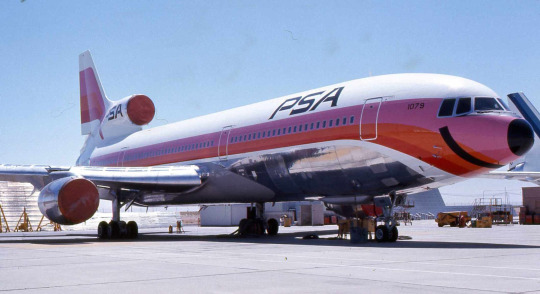
image: Piergiuliano Chesi
The name "grinningbird" is literal. PSA's fleet was lovingly painted with massive smiles directly under their noses. Their advertisements encouraged people to "catch our smile" across the state of California.

A preserved DC-3 in original Pacific Southwest livery
PSA was started as a single leased DC-3 hopping from San Diego to Oakland. Apparently their ticket office was literally a refitted military surplus latrine where they weighed passenger baggage on a bathroom scale. When they expanded with DC-4s they painted rectangles around the windows to make them look more like DC-6s. This was in 1955. And then, by the early 60s, they were taking off.
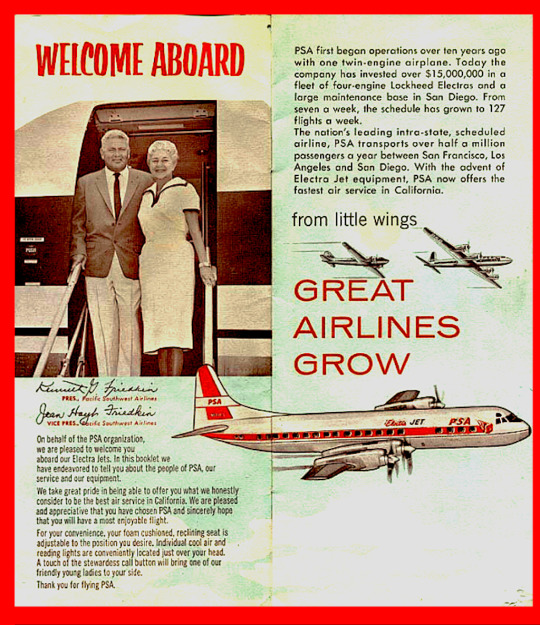

A pre-smile PSA Electra. The L-188 Electra is, of course, my favorite jet plane. image: Jon Proctor
It was in the 60s that their planes stopped saying 'Pacific Southwest Airlines' and started just being PSA, and it was in the 60s when they caught their smiles. This was the point when PSA became PSA, transforming from just another intrastate airline in the pre-deregulation era to a turning point in aviation history.
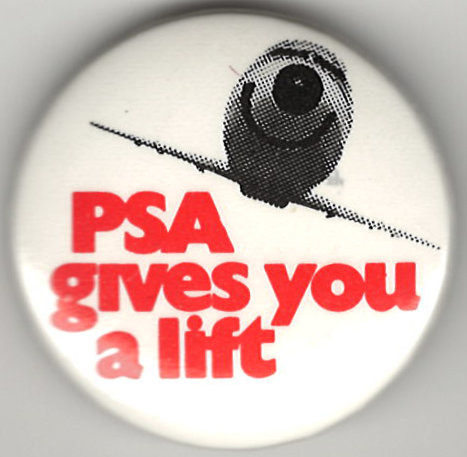
a 1972 promotional button image: psa-history.org
While the smiley faces are the most significant historical fact about PSA, also notable is the fact that they were the first low-cost carrier in history. Although PSA's routes were limited to Southern California, they charged $9.99 for a ticket other airlines would charge $13.50 or $22.05 for - and keep in mind that in today's money that's a difference of hundreds of dollars. Free of federal fare taxes and operating frequently, PSA grew at an intense pace with its new fleet of Lockheed L-188 Electras.

I love the L-188 Electra (not to be confused with the earlier L-10 Electra best known for Amelia Earhart reasons). Although Lockheed has long since moved over to exclusively making weapons for killing people, back when they were in the civil airliner market they made the most incredible planes which somehow ended up commercially flopping time after time. The Electra, for instance, was all but killed immediately by two early crashes caused by a sneaky design flaw. These were fixed, but the type's reputation had already been sullied. (Interestingly, similar early design flaws with far less prompt responses failed to kill either the DC-6 or the DC-10, despite the latter causing the deadliest crash in history at the time and the former having had the serious potential to give us a timeline where the President of the United States was killed because his presidential transport had a design flaw which encouraged going up in flames midair.) Ironically, the Electra is actually an insanely reliable and sturdy plane, and the example pictured is still in service as an air tanker under the registration C-GZCF, still doing her thing at just 63 years young. (Another Electra in Air Spray's fleet is a similar age but also survived being bisected across the belly by her own detached propeller, and she literally flew two days ago. These planes are on a level only shared with Nokia cell phones, especially for their size.)
That paragraph became about the Lockheed L-188 Electra. I did not mean for it to be, but I am leaving it in, because I love this plane. Looks great with the smile, too. The roundness of the nose gives the distinct appearance of something like a teddy bear snout.
From this point things only grew quicker. PSA continued to be PSA, acquiring more aircraft to fly more passengers. They did expand routes eventually, and once the 1978 Deregulation Act allowed they flew to some other states and even Mexico. Despite this, they remained an icon in their home state, and are often called "the unofficial flag carrier of California".
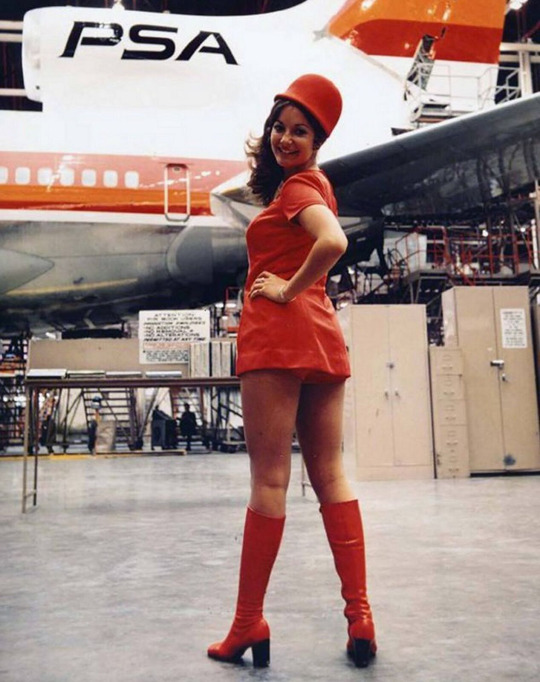
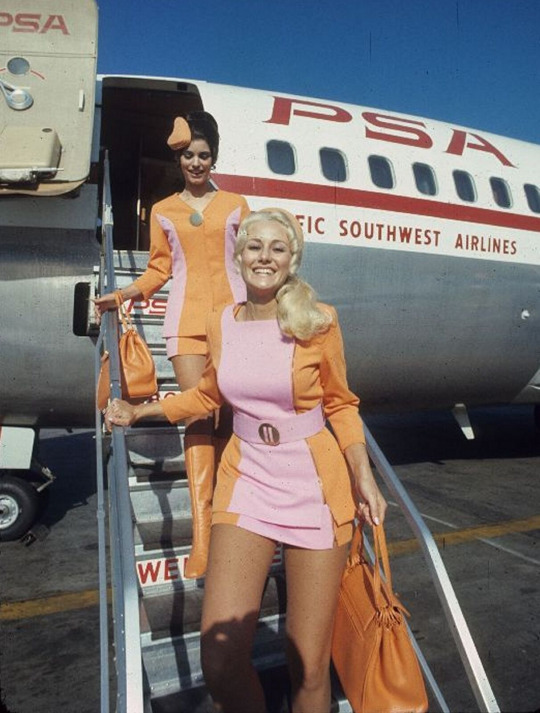
PSA stewardesses. I can't find an original source for either of these pictures, which have been widely spread without context or credit - although significant effort has been made to archive PSA's promotional content, a lot of it is, sadly, free-floating orphaned bits.
PSA's stewardesses wore bright pink and orange uniforms of miniskirts, hot pants, and go-go boots. They were encouraged to joke around with passengers, and so were the pilots. Other airlines at the time were still only slowly losing the unapproachable aura they had cultivated of stiff, sterile luxury and gravitas. PSA would get you where you needed to go without any fuss and they'd charge you half as much for it. And they weren't sloppy, either. Despite their low fares, PSA was incredibly safe, having one fatal accident in a span of time where American Airlines had 16, and even though nostalgia is obviously a factor I've only ever heard glowingly positive accounts of PSA, its service, and its staff.
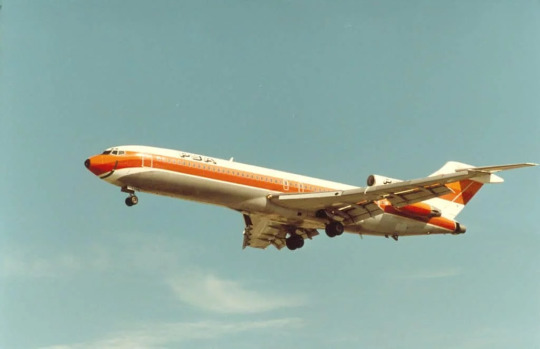
image: Bill Larkins
PSA's fleet was...eclectic. Though they operated a few very popular models, like the Boeing 727 and McDonnell Douglas MD-80 series, a lot of their offerings were somewhat uncommon. The plane in my profile picture is one of their two L-1011 TriStars, another of Lockheed's underappreciated airliners and by far the most advanced wide-body aircraft of its time. PSA was unique in that it operated a jumbo jet, their "Mother Grinningbird", on a route that was not just domestic, but intrastate. They also apparently operated a single Bell 206 helicopter, which I can find no additional clarification on. Lastly, they flew one of the oddest airliners ever built in both function and appearance, the British Aerospace 146.
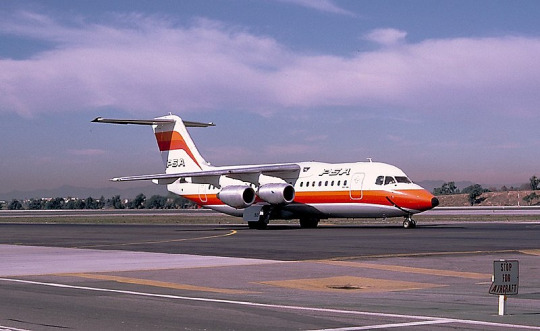
Just your regular high-wing jet. No thrust reversers necessary. Western-made but rocking the Il-76 wing anhedral. Super quiet because the powerplants are based off what you'd put on a helicopter. Seats less people than a 737-200 - six-across layout for maximum discomfort - and flies exclusively puddle jumps...yeah, I think four sounds like the right number of engines. image: Ted Quackenbush
Across all these planes, they found a livery that worked and they kept going with it. The reason this post is so long is to give context to just how important this livery is. The grinningbirds were what started low-cost carriers, paving the way for the silly names of jetBlue airplanes in a future its founders couldn't even have imagined. The shift to approachability over prestige in airline marketing was PSA's lasting gift to aviation, as were the low fares and the knowledge that a 'budget' airline didn't have to be dodgy or unpleasant - they just had to charge less than TWA and Western.
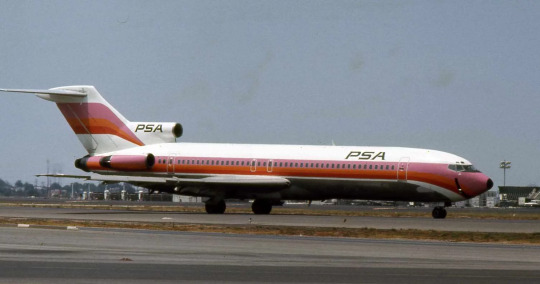
image: Piergiuliano Chesi
PSA's colorscheme was incredibly vibrant. The red and orange colors feel warm and tropical, complementing the California sunshine in which these planes spent their time. Earlier liveries also had a shocking hot pink shade above both, though it was eventually painted over due to issues with paint fading - I think the livery is vastly improved with its presence, but I suppose needs must. Despite the airline serving commuters more than vacationers it puts one in mind of things like beaches and ice cream stands - warm, high-energy things. The sorts of things one might smile about, if they like those things. I hate those things, but these planes make me like the idea of them, because they're just so darn happy to take me there!
The design of the fuselage is incredibly bold despite not using much more paint than any other airline of the day. While the striking colors definitely contribute to the overall look being more than the sum of its parts, I think there's also a few bits of clever design that really elevate the design of the plane.

The tail has a design almost like an inverse hockey-stick. Instead of following the cheatlines for maximum sleekness it chooses to diverge from it, creating a sharp angle that keeps the aerodynamic feeling while feeling fresh from similar designs of the time. By having the thin line from the tail trailing down towards the fuselage it prevents the block of empty space on a regular hockey-stick livery, where the forward portion of the empennage is fully unpainted, and creates a feeling of continuous color and excitement while keeping some staccato punch.
Similarly subtle yet effective are the stripes themselves. They aren't of an equal width - rather, the red stripe is thinner than the orange one, and in planes with the additional pink stripe this one is even wider. It feels a lot more dynamic than simple even-width stripes, feeling almost as if you can see the colors start to mix into each other. The 'mixing' feeling is helped by the fact that the cheatlines wrap under the nose instead of simply ending where they meet. The small painted white line under the main colored ones, above the unpainted metal of the underbelly, creates basically an extra two stripes for the price of one despite being so subtle many people probably didn't notice it.
On its own, the design of the bodies of PSA planes is already good, but it practically ceases to matter when you get to the face.

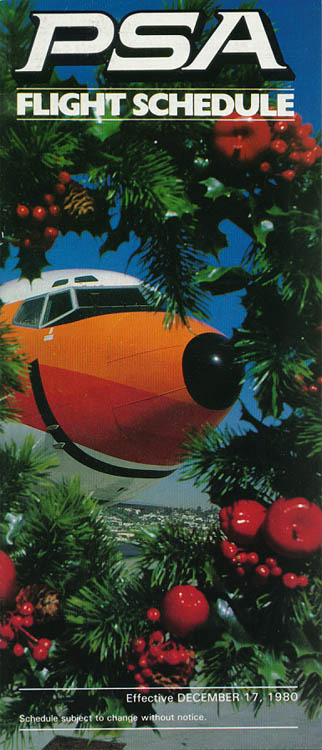
The way the top line of color wraps around the back of the cockpit windows makes it look almost like the plane is wearing sunglasses. And then there's the little painted black nose and, of course, the huge ear-to-ear grin. I don't really know what else to say about this because it's all been said time and time again.
I genuinely don't know how else to express it. PSA's livery was gorgeous and it was perfect for PSA. In all honesty, I don't think it's possible to improve it at all. My one slight criticism is that the actual PSA wordmark, though designed well, is a bit small and out of the way, but to be totally honest it's barely necessary. You see the smile and you know exactly who that plane is flying for.
PSA gets a PSA+.
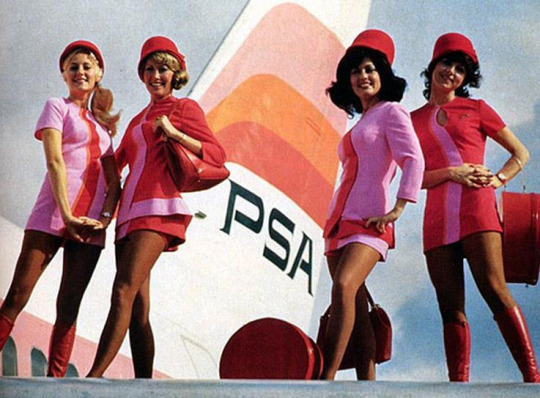
So what happened to PSA, if they were so successful? Did an economic shift catch them off-guard? Did some demographic evolution rob them of their old customer-base? Did a change of management result in a new owner running the airline into the ground? Did it have anything to do with the fact that the one time they were involved in an accident it spent eight months as the deadliest crash in US history?
Nope. They got bought out by USAir because they wanted more routes on the West Coast.
Yeah. That's the story. Neither a bang nor a whimper. They left one morning and didn't come back. That was the end of PSA, the first-ever low-cost carrier, California's most beloved airline, and one of the best-designed liveries in airline history if not the very best.
There is, however, one final twist. USAir eventually was sucked into the gaping maw of American Airlines. With this merger American Airlines also inherited the rights to PSA's IP. In classic fashion, they created a wholly-owned subsidiary by the name of PSA Airlines, just to make sure nobody else could get the trademark.
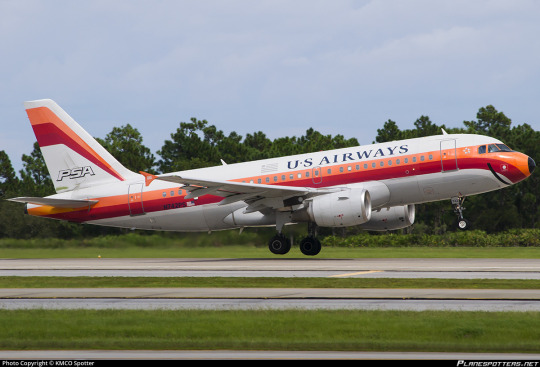
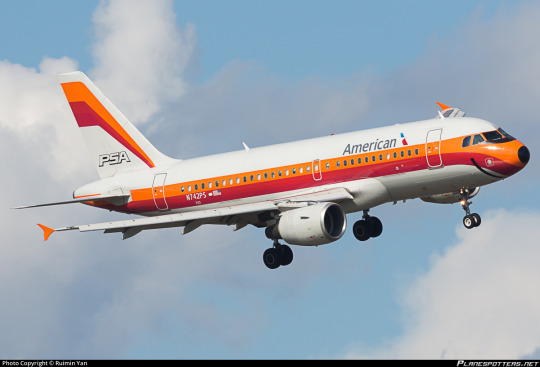
Under the iron fist of first US Airways (USAir's eventual rebrand) and later American Airlines, we were allowed one last grinningbird - an Airbus A319-100 registered N742PS. It's strange, seeing the PSA livery on a model of airplane they never operated. It's a rare example of the design on airframes that have that rather distinct 'default' modern empennage, all sharp and tall with no t-tail or third engine. The implementation could take some notes and the colors look bizarrely plastic, but I will never stop loving her no matter how much they take from her. How could I not, with that smile?
Unfortunately, in April of this year she was re-painted to a standard American Airlines livery. Although the Allegheny and Piedmont heritage liveries were removed at the same time, I almost don't even notice their absence because of the loss of our very last holdout from a much more colorful time and place. Part of me feels a sort of ripping-the-bandaid-off relief at it. American Airlines shouldn't get to parade around the skin of a much better livery worn by a much better airline. That isn't theirs; they didn't earn it. And there's no way to rebuild PSA now that times have changed and the industry is unrecognizable from the days when a ticket from San Diego to Burbank cost $9.99. All the same, the loss of yet another smile hurts. There's no way it wouldn't. And at the end of the day it makes me feel a little dead inside just imagining the mindset of the American Airlines executive who walked by her in the hangar and instead of smiling back gave the order to paint her white. And that day, the sky got a little less colorful and a lot sadder.
Maybe, in a strange sense, the way it happened is better. Nobody ran PSA into the ground. They did not cause some sort of reputation-ruining accident through willful negligence. Their customer service did not decline until they were widely grumbled about. They didn't die infamous for poor safety and loose morals like Pan Am, or splitting at the seams and betraying their reputation like Chalk's Ocean Airways. No, I don't think an organic shriveled going-under would have held any more dignity than this. I think the ending PSA got is as graceful as the ending to something like PSA could be. There is no end to the glory days which forces itself into our memories. There is no decline. No sunset to fly off into. There is a loss to mourn, but no accompanying moment to curse. Lost at sea, ship never found, nothing to imply a terrible fate; all we know is the poor sailors aren't here anymore.
Maybe it's not universally known to people who aren't interested in subjects that bring them close to it, but to those of us who love planes PSA is truly special. Its quiet apotheosis has made it synonymous with the very best an airline could be. The joy of a time where a regular person could finally afford their first plane ticket and be greeted by colorful people who talk to them like friends, where even the planes are smiling, is encoded into the DNA of PSA's remnants, into every anecdote told by an aging former stewardess and into every Polaroid taken of one of those smiling planes parked on a sunny California tarmac. It was there, and then it was a distant echo of warm breezes and idle chatter that feels almost close enough to reach out and touch. PSA never died. One day it was flying passengers to their destinations, planes smiling their same smiles. The next day it was fond memory, already graduated to the distant sunny shores of nostalgia.
youtube

#tarmac fashion week#grade: a+#region: north america#region: united states#era: 1960s#era: 1970s#era: 1980s#pacific southwest airlines#requests#defunct airlines#regional airlines#double sunrise#long haul#galley gala
107 notes
·
View notes
Text
Section 1: Planning Your Budget Vacation
1.1 Setting a Budget
Establish a clear budget for your trip, factoring in transportation, lodging, meals, and activities. Use budgeting tools or apps to keep track of expenses and prioritize your spending.
1.2 Researching Destinations
Some destinations offer more value than others. Research places known for their affordability, such as Southeast Asia or Eastern Europe, and consider traveling during the off-peak season to save on costs.
1.3 Travel Tips
Utilize travel apps and websites to compare prices. Set alerts for flight deals and be flexible with your travel dates to take advantage of the best rates.
Section 2: Finding Affordable Accommodation
2.1 Types of Budget Accommodation
Explore a variety of budget options including hostels, motels, and guesthouses. Look into vacation rentals that can offer more space and amenities for families or groups.
2.2 Best Platforms for Booking
Platforms like Booking.com, Hostelworld, and Airbnb provide a range of options. Learn to navigate these sites effectively by using filters and sorting features to find the best deals.
2.3 Unique Stays on a Budget
Consider unique lodging options such as glamping sites, houseboats, or tiny homes. These can provide memorable experiences without a hefty price tag.
Section 3: Affordable Vacation Packages
3.1 Understanding Vacation Packages
Vacation packages often combine flights, hotels, and sometimes activities at a lower cost. Understand how these packages work to maximize your savings.
3.2 Where to Find Deals
Research travel agencies that specialize in budget trips, and don’t forget to check out last-minute deals on various travel websites.
3.3 Tips for Creating Your Own Package
Learn how to bundle flights and accommodations effectively. Use examples to demonstrate how to save by planning your own itineraries.
Section 4: Activities and Attractions on a Budget
4.1 Free and Low-Cost Activities
Highlight free activities available at your destination, such as hiking, city walking tours, and local markets.
4.2 Discounts and Passes
Promote the idea of city passes that offer discounts on attractions and public transport. Share tips on how to take advantage of student and senior discounts.
4.3 Making the Most of Your Destination
Encourage travelers to explore local cuisine through affordable street food options. Highlight the importance of connecting with locals for insider tips on budget-friendly activities.
Section 5: Travel Hacks for Saving Money
5.1 Transportation Tips
Provide tips for finding cheap flights, such as using budget airlines or flying during off-peak hours. Explain how to navigate public transportation in new cities.
5.2 Packing Smart
Offer advice on packing light to avoid baggage fees and the importance of bringing essential items like reusable water bottles and snacks.
5.3 Money-Saving Apps
List apps that help travelers save money, such as Skyscanner for flights, HotelTonight for last-minute hotel deals, and GasBuddy for road trips.
Section 6: Real-Life Success Stories
6.1 Case Studies of Affordable Trips
Share inspiring stories from travelers who managed to explore new destinations on a budget. Include their favorite tips and tricks.
go for more @towardsway.in
2 notes
·
View notes
Text
A federal judge Tuesday blocked JetBlue Airways’ purchase of Spirit Airlines after the Justice Department sued to stop the merger, saying the deal would drive up fares for price-sensitive consumers by taking the discount carrier out of the market. JetBlue’s proposed $3.8 billion purchase of discounter Spirit would have produced the country’s fifth-largest airline, a deal the carriers had said would help them better grow and compete against larger rivals like Delta and United. “JetBlue plans to convert Spirit’s planes to the JetBlue layout and charge JetBlue’s higher average fares to its customers,” U.S. District Court Judge William Young wrote in his decision. “The elimination of Spirit would harm cost-conscious travelers who rely on Spirit’s low fares.” The decision, handed down Tuesday, marks a victory for a Justice Department that has aggressively sought to block deals it views as anti-competitive. “Today’s ruling is a victory for tens of millions of travelers who would have faced higher fares and fewer choices had the proposed merger between JetBlue and Spirit been allowed to move forward,” Attorney General Merrick Garland said in a statement. “The Justice Department will continue to vigorously enforce the nation’s antitrust laws to protect American consumers.”
8 notes
·
View notes
Text
Amazon deliveries could be headed for some turbulence in the new year. Pilots for US-based Air Transport International, a cargo airline that ferries Amazon packages from its fulfillment centers to airports nearer to its customers, voted to authorize a strike last month. During the three and a half years the union has been negotiating with ATI, wages in the industry have soared, and ATI’s pilots complain that their pay has fallen behind. Meanwhile, they say ATI is facing record attrition as pilots jump ship to better-paying carriers.
A strike could throw a wrench in Amazon’s logistics network. ATI, owned by holding company ATSG, operates half of the 80 US aircraft currently in service for Amazon, according to an estimate by Planespotters. But the pilots, who are represented by the Air Line Pilots Association union, can’t walk out until at least next year.
Federal law requires airline labor disputes to be mediated by the US government’s National Mediation Board, which will implement a 30-day cooling-off period if it determines the parties have reached an impasse and they refuse arbitration. If a resolution isn’t reached during that time, the pilots can walk off the job or the airline can lock them out. Some 98 percent of ATI’s 640 pilots participated in the vote and only one didn’t vote to authorize the strike.
Amazon outsources the operation of its air service, which it calls Amazon Air, to a small network of cargo airlines whose pilots fly Amazon-branded planes. In the US alone, they collectively operate more than 330 daily flights for Amazon between more than 50 airports, according to the logistics consultancy MWPVL International.
Most airlines that work with Amazon also devote a large share of their businesses to transporting cargo for other customers, including DHL and the US military. In recent years, ATI has gone all-in on the retailer, however. Amazon deliveries now comprise 94 percent of ATI’s flying hours, according to the pilots’ union, making the company and its workers dependent on the ecommerce giant.
ATI’s pilots’ union says that more than a third of the airline’s pilots have left so far this year, after 27 percent of them departed last year. The union says 42 percent of its pilots are currently on probation, meaning they’re in their first year of service. “We’re watching our carrier disintegrate,” says Mike Sterling, chair of the ATI pilots’ union.
The pilots’ union says they have delivered a 98 percent on-time performance rate, but the rapid turnover and declining experience levels are threatening that. “This market is highly competitive, and ATSG is diminishing its ability to provide quality service to Amazon,” says Sterling. “We think this is a conversation that needs to be had between all three parties.” Amazon and ATI did not respond to requests for comment. During an earnings call in May, ATSG’s former CEO said that ATI’s service quality remained outstanding, but acknowledged that training replacements for departing pilots had raised costs for the airline.
When the pilots’ union negotiated a contract with the company in 2018, pilots’ pay, benefits, and schedules were competitive with similar airlines, says Josh Hoy, a captain who started at the airline seven years ago. He initially looked at the job as just a stepping stone but decided to stick around when ATI’s relationship with Amazon took off. “It was a really exciting time, being on the ground floor of that kind of growth,” he says. “I started to have the conversation with my wife and said, ‘I think this might be the place to stay.’”
However, “as time went on, we’ve fallen far behind,” Hoy says. ATI’s union says its pilots are paid less on an hourly basis than those at all of Amazon’s seven other carriers. “We operate under the same rules, in the same airspace, on the exact same routes. The airplanes cost the exact same to operate,” says Hoy. “Everything is exactly the same, except for our pay.”
No Fondness for Labor
Amazon generally goes to great lengths to avoid engaging with unions and to deter its employees or those who work for its contractors from joining them. The company spent the last year and a half unsuccessfully challenging the first and only union victory at a US Amazon warehouse. When employees of a delivery contractor in Southern California unionized earlier this year, Amazon refused to jointly bargain with the workers and terminated its agreement with the contractor. “Amazon has not demonstrated a real fondness for labor,” Sterling acknowledges. “I would love to change that narrative with them.”
The last and only time Amazon faced a strike by one of its air carriers was in 2016, during the early days of its air cargo operation, when 250 pilots for ABX Air walked off the job. A judge deemed the strike illegal, however, and ordered the pilots back to work the following day. Nonetheless, a former Amazon Air employee told WIRED last year that Amazon suspended its business with ABX for several weeks after the strike ended to demonstrate the relative power it held in the relationship, which soon soured.
ATI’s pilots are taking a less antagonistic tone in hopes of bringing Amazon to the negotiating table. “What we don’t want to do is affect our customers,” says Sterling. “We’ve done a lot to protect our obsession with Amazon.” However, he says the intransigence of ATSG’s management has left the pilots with no choice but to call a strike.
“This side of Amazon’s network is the most vulnerable to labor strikes,” says Marc Wulfraat, president of logistics consultancy MWPVL. If drivers or warehouse workers strike, the company can shift the flow of products and packages to one of its many nearby warehouses, but airports are fewer in number and farther apart.
Amazon could compensate for a walkout at ATI by shifting volume to other air carriers under the Amazon Air umbrella, but only if they have the capacity to handle the influx at all of the airports. It could also transport some of its packages by truck instead, which it did during the brief 2016 strike. However, this could result in slower shipping times and reduced service, says Wulfraat, which flies in the face of Amazon’s mantra of customer obsession.
Pilots also have the advantage of being generally in a strong position across the airline industry. “It’s still a very, very hot job market” for pilots, says Geoff Murray, a partner who works on aerospace at management consultancy Oliver Wyman. Plummeting demand for passenger pilots during the pandemic sent many into early retirement, worsening an existing pilot shortage that got more acute as the industry bounced back. Wages have soared. Oliver Wyman estimates that captains’ pay at the US mainline carriers, such as Delta and UPS, has increased 46 percent since 2020, while regional carriers have increased pay by 86 percent.
Pilot Drew Patterson came to ATI in 2021, attracted by the work-life balance the airline offered, but as the carrier lost pilots, he has seen his workload creep up and his schedule become more unpredictable. With fewer crews to operate the same number of flights, “everybody else's schedule gets compressed,” he says. “Sometimes you can be away from home for a long time.”
Long-term, he thinks Amazon’s continued growth should be a good thing for ATI and its employees, so he’s been willing to stick it out. But he’s not so sure all of his colleagues will feel the same about current conditions at the company.
“All of this has a real house-of-cards feeling to it,” says Sterling. “We just can’t sustain what we’re doing.”
11 notes
·
View notes
Text
BEST PPC SERVICES FOR AIR TICKETING WEBSITE
Looking for the best Google Ads PPC for air ticketing website? We can help you setup PPC for flight booking campaigns at a low cost per acquisition, which was managed and run by our experts at a low cost per click. Get Call only Ads for Travel Call Leads Campaign, Google Ads for Flight Booking, Airlines Calls Campaign in Spanish, PPC for flight booking.
Why choose PPC for air ticketing website
instant visibility: PPC ads provide instant visibility, in comparison to organic search techniques, which may require months to show results. As soon as the marketing effort launches, your ads display at the top of search results, bringing rapid traffic to your website.
targeted advertising: PPC makes it easy to target users precisely on the basis of different factors that include their location, interests, search history, and even the device they are using. this meeans you can now coonect with different travellers looking for flights to particular location
Cost-effective Marketing: PPC is an affordable method of drawing highly-intent visitors to your website because this pay-for-performance model guarantees that you are going to get response for your investment. PPC advertising only costs you when a user clicks on your advertisement.
Key Strategies for Effective PPC Campaigns in Travel
To create effective PPC campaigns in the travel industry, several key strategies can be employed. These include:
Thorough Keyword Research: As the cornerstone of every successful PPC campaign for travel companies, conducting extensive keyword research is crucial.
Target High-Intent Keywords: In order to increase conversions and attract consumers who are prepared to make a purchase, concentrate on targeting keywords that show a high level of purchase intent.
Location-Based Targeting: Since almost half of experience bookings take place after a tourist reaches their destination, targeting location-based searches might be beneficial.
Landing Page Optimization: Make sure your landing pages are set up to effectively convert site visitors into paying clients. They have to be easy to use, load rapidly, and provide appropriate material that lives up to the advertisement’s claims. Conversion rates can be considerably raised by a smooth reservation process.
Monitor and Adjust Campaigns: For PPC campaigns to be successful, ongoing monitoring and modifying are necessary. Examine performance indicators including cost-per-click (CPC), conversion rates, and click-through rates (CTR). Make adjustments to your bidding tactics, ad wording, and keywords using this data.
CONCLUSION
An effective PPC campaign may hold the key to greater visibility, more traffic, and higher sales in the highly competitive marketplace of online travel. Your airline booking website can achieve unparalleled profitability by collaborating with professionals and employing effective pay-per-click strategies. With our expert PPC services, you can get started on the path to success right now.
2 notes
·
View notes
Text
WestJet will wind down Sunwing Airlines and integrate the low-cost carrier into its mainline business within two years as part of a strategy to streamline operations amid fierce competition. The move, announced in an internal memo obtained by The Canadian Press, has raised questions among some industry observers about the impact on airfares and travellers' flight options. Sunwing Airlines president Len Corrado said in the memo the change will open up markets for the 18-year-old company as well as its workers. "WestJet will eventually move to a one jet aircraft operating certificate (AOC) model and Sunwing Airlines will be integrated into WestJet. This is a long-term move that will unlock greater scale and growth opportunities for our people, and specifically for our airline employees within the group," Corrado said in the memo, dated Wednesday. [...]
Continue Reading.
Tagging: @politicsofcanada
13 notes
·
View notes
Text
Global Drilling Dynamics: A Comprehensive Overview of Directional Drilling Services Worldwide
Directional drilling is technique where multiple holes are dug from same surface. This form of digging is used by oil companies for accessing the reservoir of oil which saves the operational cost and done with less damage to the environment. The directional drilling has been a part of oil industry for a longer period. The use of Directional Drilling has economic uses as well for the oil drilling companies because it has low maintenance and low equipment cost which is why it is preferred mainly. With the rising demand for sources of energy, companies are investing huge amount into advanced methods for drilling services. Use of advanced tools and technique for the discovery for finding new reservoirs with minimum expense and drilling them to bring out maximum output. The market will be driven by increasing demand for energy, rapid industrialization.
Request The Sample PDF Of This Report: https://www.alliedmarketresearch.com/request-toc-and-sample/14171
COVID-19 Impact analysis
The COVID-19 outbreak has highly impacted the oil & gases market. With rise in cases day by day, countries have been under complete lockdown. This resulted in low sales of automobiles and halt in industries such as airlines, transportation, and oil production.
The companies have to follow the lockdown protocol and shut down their production unit as per government rules and regulation. Also, because of shortage of labor and including their safety. Many ongoing projects have to be temporarily ceased with immediate effect. The oil & gas price and supply have been affected globally.
Top Impacting Factors
The population is growing rapidly and so is the demand for energy. The demand is more from developing countries owing to increasing infrastructure and changing lifestyle of people. To cope with the demand, it has become important to discover new oil and gas fields, to meet the energy demand. Thus, the market has been expanding due to increasing investment. The fluctuating crude oil price in the global market oil field operators are cutting down their expenses in field operations. Also, the government is now strict on the oil & gas mining. In several regions, government has applied some rules and regulation regarding the safety of workers and environment. The companies have to submit a rough plan to the government about their drilling plans and environment safety measures which they are taking. Apart from this, the list of equipment to be used and an evacuation plan in case of emergency if anything happens. Before drilling to get the permissions can take time and slower down the production and increase in production cost, which is expected to hamper the directional drilling services market. The increase in adoption of green energy sources will reduce dependency on oil & gas in the future is expected to affect the directional drilling services market.
Market Trends
The growing investment in off-shore sector to find more reservoirs and increase the oil & gas production. This makes it the fastest growing segment into the market. Countries like China, America, and Russia have already invested, because the cost of offshore drilling has declined over the past few years.
Currently the demand for coal, gases and fuels for transportation has been increasing due to globalization and urbanization, which needs the expansion of oil & gas industry and biggest market vendors such as China, Russia and the U.S. have increased their investment in search for oil fields.
The increased use of energy has expanded the global oil & gas industry. They are mainly used for the purpose of transportation, power generation, and industrial use with many other industries.
Technological advancement which helps drillers to go into more depth and advancement of drilling tools with better visibility under the water, America is dominating the market because of their better technology.
Countries which are largest consumer of oil & gas are China and the U.S.; they are investing more into renewable source of energy power generation to reduce carbon emission and their dependency on fossil fuels. They are setting hydro, solar and wind power energy substation at a larger extent, which will affect the oil, gas and drilling market at a larger level.
Enquiry Before Buying : https://www.alliedmarketresearch.com/purchase-enquiry/14171
Key Benefits of the Report
This study presents the analytical depiction of the directional drilling services industry along with the current trends and future estimations to determine the imminent investment pockets.
The report presents information related to key drivers, restraints, and opportunities along with detailed analysis of the directional drilling services market share.
The current market is quantitatively analyzed to highlight the directional drilling services market growth scenario.
Porter’s five forces analysis illustrates the potency of buyers & suppliers in the market.
The report provides a detailed directio
Directional Drilling Services Market Report Highlights
Aspects & Details
By Drilling Technique
Conventional Methods
Rotary Steerable System
By Service Type
Rotary Steerable System (RSS) Logging-While-Drilling(LWD
Logging-While-Drilling(LWD
Measurement-While-Drilling (MWD)
Motors (MUD Motors)
Get a Customized Research Report @ : https://www.alliedmarketresearch.com/request-for-customization/14171
By Application
Onshore Applications
Offshore Applications
By Region
North America (U.S, Canada, Mexico)
Europe (Russia, France, Germany, Italy, Spain, UK, Rest of Europe)
Asia-Pacific (China, Japan, India, South Korea, Rest of Asia-Pacific)
LAMEA (Brazil, Saudi Arabia, South Africa, Rest of LAMEA)
Key Market Players
Weatherford International Plc, Jindal Drilling & Industries Limited., Schlumberger Limited, Baker Hughes Incorporated, Nabors Industries Ltd, Halliburton Company, Cathedral Energy Services Ltd, General Electric Oil & Gas, National Oilwell Varco
3 notes
·
View notes
Text

Boeing 787-8 Jetstar Airways
Registration: VH-VKL Type: 787-8 Engines: 2 × GE GEnx-1B Serial Number: 36238 First flight: Aug 20, 2015
Jetstar Airways Pty Ltd, operating as Jetstar, is an Australian low-cost airline headquartered in Melbourne. It is a wholly owned subsidiary of Qantas. Jetstar is part of Qantas' two brand strategy of having Qantas Airways for the premium full-service market and Jetstar for the low-cost market. The airline was established by Qantas in 2001. The airline operates an extensive domestic network as well as regional and international services from its main base at Melbourne Airport, using a mixed fleet of the Airbus A320 family and the Boeing 787 Dreamliner. On all Boeing 787 international routes, Jetstar offers a two-class service.
Poster for Aviators. aviaposter.com
3 notes
·
View notes
Text
Ben Baldanza: Transforming Spirit Airlines into a Low-Cost Powerhouse
Ben Baldanza: The Visionary Behind Spirit Airlines’ Transformation Ben Baldanza, a dynamic figure in the aviation industry, is celebrated for his remarkable ability to turn around a struggling airline named Spirit Airlines into a lucrative enterprise. Through a distinctive blend of ultra-low fares, minimalist service, audacious marketing strategies, and an unapologetic stance on customer service,…
#airline marketing#airline transformation#aviation industry#aviation news#bare fare model#Ben Baldanza#budget airline#customer service#low-cost airline#Spirit Airlines
0 notes
Text
Low-Cost Carrier Airlines Market: Redefining Air Travel
Low-cost carrier airlines, often known as budget airlines, have transformed the aviation industry by making air travel more affordable and accessible to a broader range of passengers. In this article, we will delve into the current landscape of the low-cost carrier airlines market, the factors contributing to its growth, and the promising future that lies ahead.
Low Cost Carrier Airlines Market Introduction
Low-cost carrier airlines have disrupted the traditional aviation model, offering passengers affordable fares while maintaining efficiency and profitability. These airlines have redefined air travel, making it a popular choice for both leisure and business travelers.
The Current State of the Low-Cost Carrier Airlines Market
1. Affordability
Low-cost carriers are known for their competitive pricing. They offer no-frills, point-to-point service, allowing passengers to pay only for the services and amenities they need, avoiding unnecessary fees.
2. Network Expansion
While initially focused on short-haul routes, many low-cost carriers have expanded their networks to include long-haul destinations. This expansion has broadened their customer base, attracting travelers looking for budget-friendly international flights.
3. Operational Efficiency
Low-cost carriers have streamlined their operations to reduce costs. Their operational efficiency includes quick turnarounds between flights, utilizing secondary airports, and operating a single aircraft type, which simplifies maintenance and training.
4. Passenger Experience
While low-cost carriers offer basic services, passengers can often choose to add amenities for an additional fee. This a-la-carte approach allows travelers to personalize their flying experience.
5. Market Share
Low-cost carriers have gained a significant market share in regions like Europe, the United States, and Southeast Asia. They are increasingly competing with legacy carriers and dominating certain markets.
Low Cost Carrier Airlines Market Analysis
The low-cost carrier market is experiencing substantial growth, with key insights into its current status:
1. Market Size
The global low-cost carrier market is estimated to be valued at over $130 billion in 2023 and is projected to continue expanding. This growth is driven by increasing consumer demand for budget-friendly travel options.
2. Regional Trends
Low-cost carriers are popular in various regions, with different brands dominating specific markets. For example, Europe has Ryanair and easyJet, while the United States has Southwest Airlines and Spirit Airlines.
3. Key Players
Major players in the low-cost carrier sector include Southwest Airlines, Ryanair, AirAsia, and JetBlue. These airlines have played a crucial role in shaping the industry's development.
Low Cost Carrier Airlines Future Prospects
The future of the low-cost carrier airlines market is marked by several exciting developments:
1. Continued Expansion
Low-cost carriers will continue to expand their networks, offering more routes and services. This expansion may include more long-haul flights to various international destinations.
2. Technological Advancements
Airlines will invest in technology to improve customer service and enhance operational efficiency. This includes mobile apps, self-service kiosks, and improved in-flight connectivity.
3. Sustainability
The industry is increasingly focusing on sustainability by investing in fuel-efficient aircraft and exploring alternative fuels to reduce their environmental impact.
4. Market Competition
Competition in the low-cost carrier market is expected to intensify, as both new and established airlines vie for market share. This will lead to innovative pricing and service strategies.
0 notes
Text
1. 'Something is wrong with Belgium,' says police union chief after NYE violence
During the New Year’s celebration in Brussels, Belgian police carried out 160 arrests within the Brussels region alone. In some areas, troublemakers targeted police officers and paramedics with fireworks. For Vincent Gilles, President of the SLFP police union, this situation is "unacceptable." Read more.
2. Belgium to test excrement of airline passengers from China for Covid-19 variants
Belgium will soon start testing the wastewater from flights coming from China to gather more information on the possible spread of new Covid-19 variants, announced Federal Health Minister Frank Vandenbroucke on Monday. Read more.
3. Flemish separatists N-VA blame language law for delays in judicial process
The Flemish right-wing separatist party N-VA has called on an amendment to the language law, as it claims the current system results in months of delays – as it allows people in Flanders who break the law to request a language change during the trial. Read more.
4. Federal Government seeking to ban non-reusable packaging in fast food chains
The Belgian Environment Minister Zakia Khattabi has proposed a ban on single-use packaging and containers for food sold at fast-food establishments. With the government planning on enforcing the ban as early as 1 January 2024, the proposal has triggered mixed reactions from industry giants such as Comeos, Burger King and McDonald's. Read more.
5. Air traffic in Europe reaches 83% of pre-pandemic levels
European air traffic returned to 83% of its 2019 levels last year, a “solid” rebound pushed mostly by low-cost carriers and holiday destinations in southern Europe, air traffic monitoring group Eurocontrol. Read more.
6. Netherlands bans flavoured e-cigarettes, Belgium also tightens rules
While the Netherlands has banned e-cigarettes with flavours since the start of this year, a transition period to withdraw them from the market will be allowed until October. In Belgium, legislation on vaping will soon be tightened as well. Read more.
7. Hidden Belgium: The statue of Vesalius
A statue of Vesalius stands in the middle of the Place des Barricades in Brussels. But the famous doctor was born a few kilometres to the west in a street in the Marolles (now vanished) called Ruelle de l’Enfer, or Hell Lane. Read more.
#nunyas news#number4 there is going to create all kinds of problems#dishwasher and person to run it is going to be one of the smaller ones
4 notes
·
View notes
Text
No. 5 - jetBlue 2: Electric Bluegaloo
I am writing this post on the 15th of June, 2023.
I was going to publish one post tomorrow. It was going to be about a completely unrelated airline from a different country. I wrote it already. I have several other posts written already, because I like writing them, and they make me excited. I had a partially written post on jetBlue. It was going to be finished soon and uploaded after that. Just one in a sea of many things people have painted onto their airplanes.
I did not plan to discuss jetBlue tomorrow. I did not plan to finish my jetBlue post today. But they have forced my hand by announcing an overhaul of their 20-year-old livery at the most inconvenient possible time for me specifically, and I suppose I'm someone who reviews airline liveries now so I'm not just going to not talk about it.
Okay, let’s see. What they’ve been doing has worked for them for two decades, so I am very curious what they...
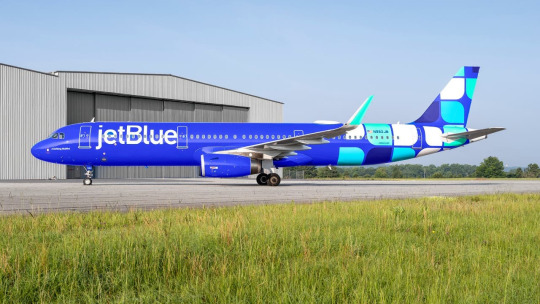
(image: jetblue)
Oh.
Huh. Not...sure what I expected. This is really taking a moment to sink in.
Well, okay. My immediate thought is ‘neat, they finally extended it past the tail’. My second thought is ‘thank goodness they're finally moving past their Eurowhite phase’. My third thought is...
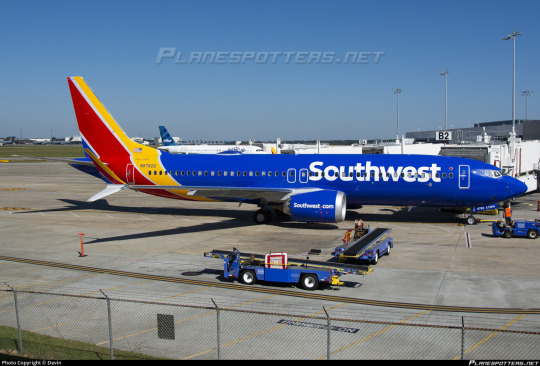
Obviously they don’t have an exclusive right to this shade of blue, but does...does Southwest know about this? You two are probably the two biggest players in the low-cost market on the East Coast, should you be...being nearly the exact same shade of blue? Like, the rest of the liveries are obviously very different, you wouldn’t confuse them even from a distance, and I'm pretty sure jetBlue's is slightly lighter, but it just feels, viscerally, like someone’s nose gear is being run over a little bit.
Okay. No. We are forgetting about this. We literally just talked about not comparing beautiful blue girls to each other. They’re going to stall or soar on their own merits. Let’s take another look at N982JB “A Defining MoMint” (neé “One Mint, Two Mint, Blue Mint, You Mint”), who is patient zero for jetBlue’s new rebrand.
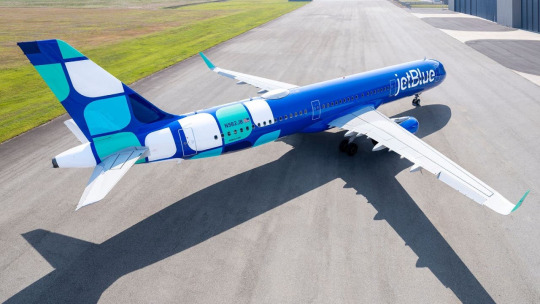
(image: jetblue)
There she is in all her eyestraining glory. I mean, there’s bright and then there’s hard to look at. jetBlue has, for some reason, decided to unleash a migraine machine onto airports across America and beyond.
jetBlue? I know you're reading this. Can we talk, jetBlue? There are a billion shades of blue you could have picked from for the main body.
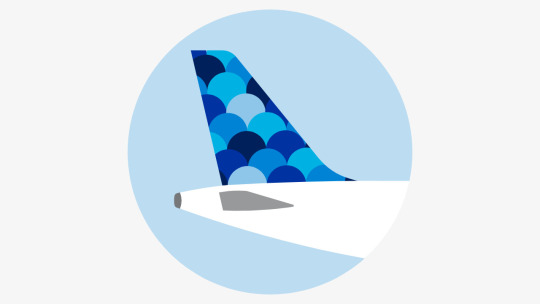
(image: jetblue)
In fact, here are five of them from your own most recent tail design. And you chose the only one that is extremely painful to look at in large quantities. So, unfortunately, we’re taking off from the wrong runway. But let’s hear what you have to say for yourself, jetBlue.
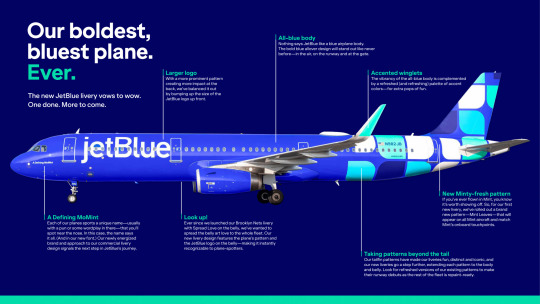
I can only imagine how badly tumblr is going to crunch this, so here’s a direct link to the PDF jetBlue put out explaining their design choices.
Well, it’s definitely one of the bluest planes they’ve ever made. I think Blueprint might actually be bluer, but that’s a discussion for later. It’s a reasonably, maybe even unreasonably, blue plane, and I think we can all agree on that.
They’ve made a lot of changes that seem almost like direct responses to my earlier complaints. Robin N. Hayes, CEO of jetBlue Airlines, are you in my head reading my mind? If you are, I think I at least deserve a couple of scale models for all the advice I’ve given you. Come on. I’ll even proofread your website for you.
Sadly, I have yet to receive my rightly deserved 1:100 model of the jetBlue retrojet, but they’ve at least recognized that I’m correct about a lot of things. The all-white fuselage is boring and the tail designs need to be allowed to unfurl from their prison on the vertical stabilizer. I’m absolutely with them on that. I actually can’t say how I feel about this new ‘mint leaves’ tail pattern. I think that I don’t like it, but it’s very hard to tell because looking at this image for too long without my darkreader on genuinely hurts my eyes. I’m sure it’ll be fine in person, but I haven’t seen this livery in person. I’ve had all of a day to process this through my computer screen, and because of that I think I sort of really dislike it!
But I also can’t commit to that opinion because it’s been a day and a half and there’s so much we still don’t know. Well, I know that this is literally the worst shade of blue that there is, but my least favorite color is orange and I think there are plenty of decent looking orange planes out there. It’s not about the base color. It’s about what you do with it. And what will they do with it? It’s...not really clear.
The thing about this launch is that if Robin N. Hayes, CEO of jetBlue Airlines, can read my mind, I can’t read his. All I have is this PDF and a couple paragraphs of copy that really raise more questions than they answer. I'm just going to paste the important bit here.
Aptly named A Defining MoMint, the first plane to sport our new livery (our first-ever Mint pattern, coming soon to all Mint planes) is an Airbus A321 with Mint—which rolls into service on 6/15/23. Look for refreshed versions of our existing patterns to make their runway debuts as the rest of the fleet is repaint-ready.
This leaves so many questions unanswered. Is this for all Mint planes? That's not an insignificant portion of the fleet. Are all the planes currently wearing the ribbon and streamer tails going to wear this exact design, or will there be multiple Mint liveries? Will the ribbon and streamer tails be retired completely? They're pretty new, that seems a bit premature to me. What about the non-Mint planes? I assume the implication is that they're going to get patterns that extend onto their main fuselages as well, but are they going to also be repainted now or will there be a gradual rollout where it'll only be Mint planes for the time being? What is even going on? Seriously, does Southwest know? How did nobody notice the two massive typos on the liveries page of your website when you updated it with this new information? Ya blue it!
This is sending me into a bit of a tailspin. This redesign is everything I should want. It's spitting in the face of the design principles that I hate so much I started this blog. It's addressing some of my complaints. But I just don't...like to look at it?
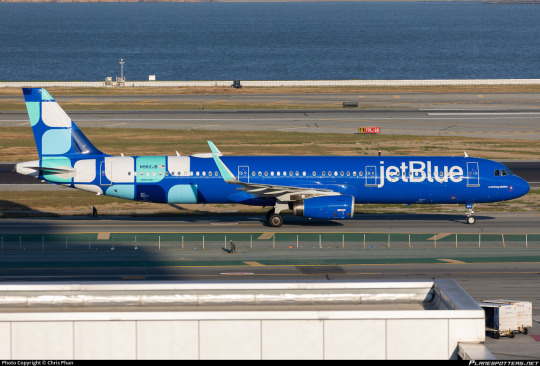
I think what's bothering me here, when my eyes adjust somewhat to the sheer piercing brightness of it, is the overwhelming amount of stuff happening. When I do focus in I can see things that I like. For example, the tail pattern seems to be almost spreading onto the main fuselage rather than being isolated on a tail with its own background color. Some things I just can't entirely process. Like the PDF says they're using a new font but I can't really tell the difference between it and the old one. I guess it doesn't matter that much.
Anyway, I'm not done complaining. On the old livery, the engines were a dark color which contrasted with the light fuselage. This is pretty common. That's for a good reason. It creates such a weird visual effect when the engines and the fuselage are the same color. When you look at them from the side they look like they're merging. Also, despite them mentioning that they made the text in the front bigger to make the livery look less rear-heavy, and the fact that it's worked to some extent, it hasn't worked nearly enough. It would really behoove them to add something else to the front.
(I'm just saying, jetBlue...if you want to be America's Fun Airline, I don't think any defunct airlines have a trademark on painting cute little faces on your airplanes. Just keep that in the back of your mind.)
I ultimately just can't reconcile my thoughts on this. I keep repeating myself and I can't seem to convince myself to like this even though I really, really want to find some way to decide that yes, this is good, actually. This is an improvement. I can't. I can't convince myself. Maybe if I chew on it a bit longer. Maybe when they show off new tail patterns they'll all look better than this. Maybe it's just the mint green that's throwing me off and it'll all be okay. Maybe I'll wake up and a perfectly designed new jetBlue livery will be standing by the side of my bed, and I won't even mind that geometry forbids every part of that scenario, and she'll be beautiful and I will remember what it felt like to first learn that jetBlue has a plane named Blue's On First. Maybe. But right now it's the 15th of June and I'm feeling an emotion I can only imagine myself sharing with cosmic horror protagonists who have stumbled on some horrible secret that destroys the foundation which until mere moments ago undergirded their entire concept of reality. I don't know how to reconcile any of this.
jetBlue...how could you blue this to me?
Provisional* Grade: D(on't Blue That)+
(provisional because I'm being very dramatic but as I've said this is brand new fresh off the livery printer, Mint condition if you will, and I've barely had any time to process it so I'll definitely revisit it at some point. But probably not soon. I'm just about jetBlued out at the moMint.)
#tarmac fashion week#runwayrunway blueses it#grade: d+#region: north america#region: united states#era: 2020s#jetblue#low cost carriers#neelemanverse#southwest airlines
69 notes
·
View notes
Text
How Small Airlines are Competing in a Saturated Market

The airline industry is fiercely competitive, with established giants dominating many routes and markets. For smaller airlines, carving out a niche in this crowded space requires innovation, strategic planning, and an unwavering focus on customer needs. Over the years, I’ve observed how small carriers have risen to the challenge, leveraging their agility and creativity to compete effectively against industry giants. Let’s explore how these airlines are surviving and thriving in today’s saturated market.
Focusing on Niche Markets
One of the most effective strategies small airlines employ is targeting underserved routes and regions. Major airlines often focus on high-traffic routes between large cities, leaving gaps in connectivity to smaller destinations. This is where smaller carriers step in, offering direct flights to locations that might otherwise be difficult to reach.
Take Allegiant Air as an example. This airline has built its success by serving secondary airports in smaller cities and connecting them to popular vacation destinations. By focusing on these underserved markets, Allegiant has cultivated a loyal customer base while avoiding direct competition with larger carriers.
Additionally, regional airlines like Cape Air prioritize connecting smaller communities, providing essential services that larger airlines may overlook. These carriers fill a critical role in the aviation ecosystem, ensuring that less populous areas remain accessible.
Offering Unique Services and Experiences
Small airlines often stand out by providing personalized and innovative services tailored to specific traveler needs. These unique offerings can range from flexible ticketing options to enhanced in-flight experiences.
For instance, Australia’s Koala Airlines has introduced a passenger-friendly initiative that places airfare payments into a trust account until the flight occurs. This measure builds trust and assures passengers that their money is safe, even if unexpected disruptions arise. Such customer-focused approaches help smaller airlines foster loyalty and differentiate themselves in a competitive market.
Another example is JSX, a U.S.-based regional carrier that markets itself as a “hop-on jet service.” JSX provides a private jet-like experience for passengers, with streamlined boarding processes and smaller, more comfortable aircraft. This model appeals to travelers seeking convenience and exclusivity without the high costs of private aviation.
Maintaining Operational Efficiency
Efficiency is the backbone of success for small airlines. Operating on tight margins, these carriers must optimize every aspect of their business to stay competitive. From streamlining fleet operations to minimizing overhead costs, small airlines excel at running lean and efficient businesses.
One strategy is to operate a standardized fleet of aircraft, which simplifies maintenance and reduces training costs for pilots and crew. For example, Ryanair, while not a small airline anymore, adopted this approach during its growth phase by exclusively operating Boeing 737s. This practice allowed the airline to keep costs low while maintaining operational reliability.
Smaller airlines also make use of secondary airports with lower landing fees and less congestion. These cost-saving measures improve profitability while offering passengers the convenience of less crowded terminals and shorter wait times.
Forming Strategic Partnerships and Alliances
Partnerships and alliances are crucial for smaller airlines seeking to expand their reach and resources. By collaborating with other carriers, these airlines can offer passengers access to a broader network of destinations while sharing operational costs.
Codeshare agreements are a common example of such partnerships. Through these arrangements, small airlines can sell tickets on flights operated by larger carriers, allowing them to extend their route offerings without investing in additional aircraft or personnel. Passengers benefit from seamless connections and integrated services.
In some cases, smaller airlines join regional or international alliances, giving them access to shared marketing resources and operational support. This collaborative approach enhances their competitiveness while maintaining their independence.
Leveraging Technology and Digital Marketing
Technology plays a pivotal role in helping small airlines compete in today’s market. From advanced booking platforms to targeted digital marketing campaigns, these tools allow smaller carriers to reach potential customers efficiently and cost-effectively.
Digital marketing strategies, including social media campaigns and personalized email promotions, enable small airlines to engage directly with their target audience. By highlighting unique services and emphasizing customer benefits, these airlines can build brand awareness and attract travelers who might otherwise choose larger carriers.
Mobile apps and user-friendly websites also enhance the customer experience, making it easier for passengers to book flights, manage itineraries, and access customer support. These technological advancements improve efficiency and contribute to a positive perception of the airline’s brand.
Adapting to Market Trends and Customer Preferences
The ability to adapt quickly to changing market trends and customer demands gives small airlines a significant advantage over their larger competitors. Unlike major carriers, which often have more rigid structures, smaller airlines can implement changes more rapidly, ensuring they remain aligned with passenger expectations.
For example, many small airlines have introduced flexible booking policies and loyalty programs to attract repeat customers. Enhanced in-flight amenities, such as Wi-Fi and upgraded seating options, also appeal to modern travelers seeking comfort and convenience.
The growing demand for eco-friendly travel has prompted some small airlines to adopt sustainable practices. By incorporating fuel-efficient aircraft and exploring alternative fuels, these carriers reduce their environmental impact and attract environmentally conscious passengers.
Prioritizing Customer Satisfaction and Loyalty
Exceptional customer service is a hallmark of successful small airlines. These carriers often have the advantage of closer interactions with passengers, allowing them to deliver personalized and attentive service that fosters loyalty.
Whether it’s addressing customer concerns promptly or going the extra mile to accommodate special requests, small airlines can create memorable experiences that encourage repeat business. Happy customers are also more likely to recommend the airline to friends and family, contributing to positive word-of-mouth marketing.
Some airlines even focus on building community relationships, sponsoring local events, or supporting charitable initiatives. These efforts help strengthen their brand image and foster goodwill among passengers and stakeholders alike.
How Do Small Airlines Compete in a Saturated Market?
Focus on niche markets with underserved routes.
Offer unique services tailored to customer needs.
Maintain operational efficiency through cost-saving measures.
Form strategic partnerships and codeshare agreements.
Use technology and digital marketing to enhance visibility.
Adapt quickly to market trends and preferences.
Prioritize exceptional customer service to build loyalty.
In Conclusion
Small airlines face significant challenges in a market dominated by large carriers, but their ability to innovate and adapt gives them a competitive edge. By focusing on niche markets, offering personalized services, and leveraging technology, these carriers have carved out their own space in the aviation industry.
As someone who has studied the strategies of small airlines closely, I can confidently say that their resilience and creativity are key to their success. While the road ahead may not be easy, the ingenuity of these carriers ensures that they will continue to play an important role in the aviation sector for years to come.
0 notes